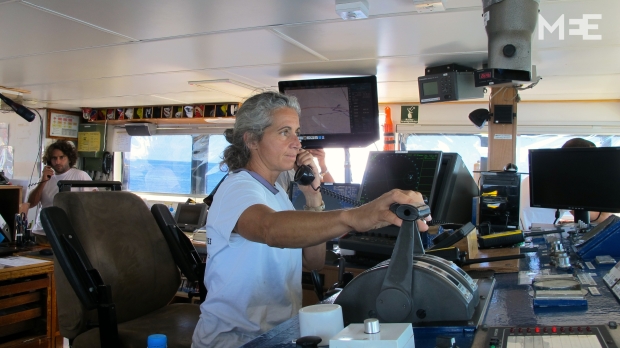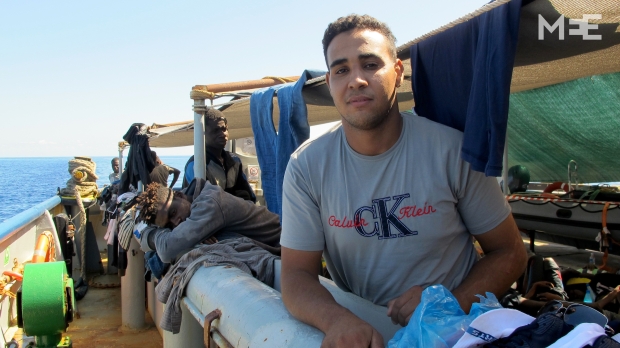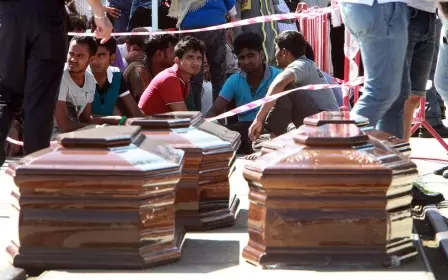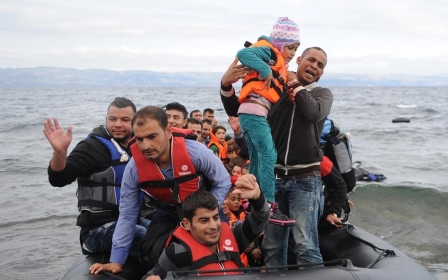'Thank you for saving my life': Aboard a refugee rescue ship off Libya
30 miles off the coast of Libya – For a journalist, the invitation was hard to decline. The mission would be eight to 10 days at sea onboard one of the rescue boats Medicins Sans Frontieres (MSF) uses to search for refugees. The experience of witnessing first-hand lives in peril saved from the waters separating Africa and Europe has etched a stark picture in my mind of the plight of refugees.
On 22 September, we set sail from the port of Trapani, on the western tip of Sicily, aboard the Dignity 1. Along with the Phoenix and the Argos, the 50-metre-long Dignity 1 is one of the three ships that make up the rescue fleet MSF has been running in the Mediterranean Sea throughout 2015.
I was not the only newcomer on board. Madeleine Habib, the new captain, told her crew about “a dream come true” after introducing herself. The 50-year-old Australian had a unique chance to combine her passion for the sea with her humanitarian commitment. For this rescue mission, Habib would also be drawing upon her experience aboard Greenpeace's Rainbow Warrior back in the 90s.
In shifts of four weeks, the Dignity 1 is home to 19 crew members. MSF project coordinator Juan Matias told me about the challenges of trying to harmonise the work of the crew and the NGO staff.
“Over the last four months the sailors have come to understand the rescue mission in its full dimension. Today, all of them are very committed with what they do,” the Argentinian told me from the small dining room of the ship, very much the main meeting point for the crew.
In the zone
The Dignity 1 needs two days to get from shore to the so called “rescue zone,” an area that stretches along an imaginary line 30 nautical miles off the coast of Libya. And we had to wait for another two days until the Mediterranean waters calmed down sufficiently for the first migrant boats to take their chances to make the crossing. It was exactly 7:50am when Habib and Matias received the first alert call from Italy’s Maritime Coordination Centre in Rome.
“We’ll be there in less than an hour so get set!” Matias told me while the ship sailed southbound at full speed toward the horizon. With the help of binoculars, we would soon spot around a hundred people crammed inside an inflatable rubber boat.
“They may look fragile but these ones are much safer than most of the boats used by smugglers: they float much more and they hardly capsize,” chief mate Porfirio Alonso told me from the deck.
As with the rest of the Dignity 1’s crew, the Spaniard witnessed the tragic capsising of a migrant boat on 5 August. More than 200 reportedly died and, according to Alonso, many of them were locked in the vessel’s hold.
According to a recent report from UNHCR more than 300,000 refugees and migrants have used the dangerous sea route across the Mediterranean so far this year. Some 2,900 of them are estimated to have died or gone missing.
However, the ones we had in sight would not fall into that category. One of the two auxiliary boats aboard Dignity 1 was already handing them lifejackets. With the help of a megaphone, Stavros Souisi gave instructions in English, French and Arabic: “We are MSF and we are going to rescue you. We won't proceed until each of you has your lifejacket on,” were Souisi's exact words.
Back on board, the 47-year-old Greek-Tunisian spoke of a “very delicate” first stage: “The main thing is to reassure them as most of them are exhausted and terrified. One false step can make the boat capsize and almost no one can swim,” stressed Souisi.
The refugees were brought on board in groups of 12. A majority of them were men, but several among the women were either pregnant or caring for their babies. Unsurprisingly, they looked far more exhausted than their male counterparts.
“Thank you for saving my life,” were the words uttered by many people as soon as they set foot on deck. Several of them would then bend on their knees to thank God. Completely surrounded by water and still in a daze, they found it difficult to orient themselves and pray toward Mecca.
On the run
That was the first of seven rescues the crew of Dignity 1 would conduct over three days. Once I had photographed a number of rescues and interviewed refugees, I decided to put the camera aside and assist the crew.
It was hectic. One could help the migrants with their lifejackets; frisk them to prevent anyone from bringing weapons aboard (there was not a single case among the nearly 800 individuals rescued); distribute bottles of water, help identify the under-aged with a tag tied with string on their wrist.
Even when you thought all fronts were covered you could still contribute in a very meaningful way by saying “welcome,” or “you’re safe”. Those simple words had a soothing effect, and could even make many of the rescued smile.
As a journalist who has covered the conflict in Libya and seen the consequences for Libyans and migrants stranded in the country, meeting those at sea who have risked their lives to find a way to a better life was humbling.
The vast majority of them were sub-Saharans, so the few North Africans on board did not go unnoticed. Most agreed that the lighter colour of their skin had helped them to avoid the terrible abuses that others had suffered in Libya. And while for most Africans Libya was merely a transit point on their way to Europe, the Maghrebis I met had tried to find a job and settle down in Libya, at least for a few years.
Such was the case of Younis Suhari. The 30-year-old Moroccan had arrived in Tripoli two years back and finally found a job driving a truck between Tripoli and Sirte. The salary, he said, was “enough to survive,” and he could even send some money to his family in Agadir, in southwest Morocco. But the deteriorating security situation in the country made the route impracticable. Unable to return home overland and without an embassy to assist him, the perilous sea route had become his only way out.
Neither was it easy for Abdul Hakim Algassi, who arrived in Libya in 2013 amid “promising” work prospects. “Three years back we all thought that things would settle in the country. Besides, there was a high demand for skilled labour, especially in the construction sector,” the 23-year-old welder recalled between the first sips of water after a strenuous journey. “But over the last year I've spent months working only to be dismissed at gunpoint and, of course, with no pay. And there is no law to protect you in Libya,” added Algassi.
The young Moroccan lamented he had been cheated until the day he jumped on the raft. “I paid 1,000 US dollars, almost double the rest of these guys because the smugglers told me mine would be a big vessel, and not an inflatable raft.”
Mohamed Shukri's odyssey across Libya speaks volumes of the ongoing chaos in the country. This 32-year-old cook from Cairo arrived in the country “a few months after Gaddafi was killed.” He was doing well in Benghazi until the fighting between rival militias forced him to leave the restive eastern city in 2014. The beheading of 21 Egyptians by the Islamic State (IS) group last February would only push him further west. “I did not dare go back to Egypt across Libya so I ended up in Tripoli hoping I'd be safe. But I was wrong,” said Shukri.
Since the Dignity 1 is a relatively small and slow vessel, Matias explained to me how they always try to transfer the migrants to a larger boat and remain in a “stand by” position on the rescue zone. Since it took up search and rescue operations in June this year, the Dignity 1 one has brought aboard more than 5,000 people from the waters of the Mediterranean. Together, the three MSF ships have rescued 17,000 people.
The majority of the refugees I spoke to said that smugglers had already told them about a “big boat” that would rescue them and bring them to Europe. Could MSF rescue fleet possibly be a “pull factor” for many? Captain Habib pointed to a “push factor”.
“Some may think we are just another link in the trafficking chain, but these people are simply fleeing terrible realities. Whether we are here or not they will continue to do so,” Habib told me from the bridge while she monitored the transfer operation to Argos, a bigger vessel bound for southern Italy.
She described the mission as a “moral obligation”. In fact, she added, “I am the daughter of an Egyptian and an Australian. We are all refugees.” Standing next to her, Matias, the grandson of Spanish immigrants in Argentina, nodded.
Middle East Eye propose une couverture et une analyse indépendantes et incomparables du Moyen-Orient, de l’Afrique du Nord et d’autres régions du monde. Pour en savoir plus sur la reprise de ce contenu et les frais qui s’appliquent, veuillez remplir ce formulaire [en anglais]. Pour en savoir plus sur MEE, cliquez ici [en anglais].








